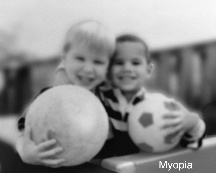Demographics
* Age range at presentation: 50 years and older
* Gender trends: None
* Racial trends: None
* Refractive error trends: High myopia
* Associated medical conditions: None
Symptoms
* Patients may experience slow, progressive loss of visual acuity or rapid vision loss in the case of exudation due to choroidal neovascularization (CNV) or retinal detachment.
Differential Diagnosis
* Age-related macular degeneration (AMD): Pathologic myopia and AMD may look similar, however, AMD is characterized by drusen and lacks significant peripapillary atrophy. In addition, patients with pathologic myopia are likely to be younger and have higher myopia.
* Angioid streaks: This condition may look similar to the lacquer cracks of myopia, however they are generally bilateral, dark in color and often emanate from the disks. Any CNV generally originates from the streaks themselves in this condition.
Manifestations
Myopic Macular Degeneration
Peripapillary chorioretinal atrophy and linear breaks in Bruch's membrane ("lacquer cracks") are characteristic findings. Choroidal vessels may be visible through the atrophie retinal pigment epithelium.
Management: Fundus photography and fluorcsccin angiography are necessary to document disease progression and to monitor for subretmal neovascularization that may be amenable to photocoagulation or photodynamic therapy with verteporfin (Visudyne).
Subretinal Neovascularization
Ingrowth of new vessels from the choroid into the subretinal space is the most important change that predisposes patients to macular scarring and irreversible vision loss. If fundus examination reveals subretinal blood, exudates or a grayish-green choroidal lesion, the likelihood of CNV is high.
Management: Fluorescein angiography helps identify and locate the neovascularization site. Because of frequent close proximity to the center of the fovea in this population, verteporfin therapy is often the treatment of choice. Rapid referral for diagnosis and treatment is necessary.
Fuch's Spot
This characteristic lesion, which may be associated with subretinal neovascularization, appears in the later stages of pathologic myopia as a raised, circular and pigmented area in the macula.
Management: Fundus photography and fluorescein angiography are necessary to document disease progression as well as monitor for subretinal neovascularization development.
Rhegmatogenous Retinal Detachment
Chorioretinal atrophy, increased axial length and vitreoretinal traction increase the risk of breaks and detachments in normal and affected areas of retina.
Lattice degeneration, representing thinned areas of peripheral retina due to chronic traction by the vitreous, is a sign of increased risk of detachment.
Management: Scierai buckling or pneumatic retinopexy are the two most common and effective surgical techniques for repairing this type of retinal detachment. Rapid referral for management is critical as surgical success increases with the promptness of treatment.
Copyright Boucher Communications, Inc. Sep 2005
Provided by ProQuest Information and Learning Company. All rights Reserved



